Flexible Compensation of Voltage and Current Unbalance and Harmonics in Microgrids
Abstract
:1. Introduction
- Simultaneous control of fundamental positive and negative sequences, as well as harmonic components of voltage and current, is achieved for three-phase DG-interfacing inverters.
- A flexible voltage or current compensation of nonlinear and unbalanced loads is proposed.
- The proposed method is applicable in both grid-connected and islanded modes of three-phase MGs.
- Four unbalanced and harmonic voltage or current compensation strategies can be achieved using this method.
2. Control Approach for DG-Interface Inverter
2.1. Power Control and Virtual Impedance
2.2. Proposed Flexible Controller for Unbalance and Harmonic Compensation
- Mode 1—unbalance and harmonic compensation of Point of Common Coupling (PCC) voltage (VPCC): in this mode, the unbalance and harmonic voltage compensation is achieved by using the following equation as input of flexible power quality controller (FPQC):
- Mode 2—unbalance and harmonic compensation of DG output voltage (VC): The capacitor voltage will be balanced if the (0-VC,αβ) is applied as the input of FPQC. The unbalance and harmonic compensation of VC is obtained by injecting FNS&H sequences of VC; hence, the performance of the inverter acts in voltage controlled mode (VCM) in FNS&H sequences. The compensation is important when a sensitive load is connected near the DG. The selection of Modes 1 or 2 is dependent on the location of the sensitive load.
- Mode 3—local unbalanced and nonlinear loads compensation: in this mode, the aim of the compensation is the unbalance and harmonic compensations of MG-injected current (Iinj). Using (Ilcaoal-I2) as input of FPQC, the multifunctional inverter acts as an active filter in negative and harmonic sequences, therefore, the FNS&H parts of unbalanced and nonlinear loads are supplied by the DG-interfacing inverter and Iinj will be balanced. The mode can be activated when there is a limitation for the unbalance and harmonics current of an MG, since each system has limitations in harmonic and unbalance injections according to IEEE 519 and EN 50160 standards.
- Mode 4—the output current compensation of DG unit (I2): in this mode, which is called the unbalance and harmonics rejection mode, the output current of DG will be compensated. This mode is important when the DG delivers maximum power to the grid, and injection of unbalance and harmonics current can increase the current of one/two phase(s) higher than the rated one.
3. Control System Design
4. Simulation Results
4.1. Grid-Connected Operation
- Step 1 (0 s ≤ t < 3.5 s): activation of Mode 1 for VPCC compensation.
- Step 2 (3.5 s ≤ t < 6.5 s): activation of Mode 2 for VC compensation.
- Step 3 (6.5 s ≤ t < 9.5 s): activation of Mode 3 for Iinj compensation.
- Step 4 (9.5 s ≤ t < 12.5 s): activation of Mode 4 for IDG compensation.
- Step 5 (12.5 s ≤ t < 16 s): disabling the harmonic and unbalance compensation (no compensation).
4.2. Islanded Operation of the MG
- Mode X: unbalance and harmonic compensation of PCC.
- Mode Y: unbalance and harmonic compensation of VC.
- ✓
- Step I:
- ✓
- Step II:
- ✓
- Step III:
- ✓
- Step IV:
5. Conclusions
Author Contributions
Conflicts of Interest
References
- Bose, B.K. Global Warming: Energy, Environmental Pollution, and the Impact of Power Electronics. IEEE Ind. Electron. Mag. 2010, 4, 6–17. [Google Scholar] [CrossRef]
- Mousazadeh, S.Y.; Savaghebi, M.; Beirami, A.; Jalilian, A.; Guerrero, J.M.; Chendan, L. Control of A Multi-Functional Inverter for Grid Integration of PV and Battery Energy Storage System. In Proceedings of the 2015 IEEE 10th International Symposium on Diagnostics Electrical Machines, Power Electronics and Drives (SDEMPED), Guarda, Portugal, 1–4 September 2015; pp. 474–480. [Google Scholar]
- Green, T.C.; Prodanović, M. Control of inverter-based micro-grids. Electr. Power Syst. Res. 2007, 77, 1204–1213. [Google Scholar] [CrossRef]
- Guerrero, J.M.; Chandorkar, M.; Lee, T.; Loh, P.C. Advanced Control Architectures for Intelligent Microgrids Part I: Decentralized and Hierarchical Control. IEEE Trans. Ind. Electron. 2013, 60, 1254–1262. [Google Scholar] [CrossRef]
- Chowdhury, S.; Crossley, P. Microgrids and Active Distribution Networks; The Institution of Engineering and Technology (IET): Michael Faraday House, Stevenage, UK, 2009; ISBN 978-1-84919-014-5. [Google Scholar]
- Mohd, A.; Ortjohann, E.; Morton, D.; Omari, O. Review of control techniques for inverters parallel operation. Electr. Power Syst. Res. 2010, 80, 4734–4749. [Google Scholar] [CrossRef]
- Reznik, A.; Simoes, M.G.; Al-Durra, A.; Muyeen, S.M. LCL Filter Design and Performance Analysis for Grid-Interconnected Systems. IEEE Trans. Ind. Appl. 2014, 50, 1225–1232. [Google Scholar] [CrossRef]
- Rockhill, A.A.; Liserre, M.; Teodorescu, R.; Rodriguez, P. Grid-Filter Design for a Multimegawatt Medium-Voltage Voltage-Source Inverter. IEEE Trans. Ind. Electron. 2011, 58, 1205–1217. [Google Scholar] [CrossRef] [Green Version]
- Savaghebi, M.; Jalilian, A.; Vasquez, J.C.; Guerrero, J.M. Autonomous Voltage Unbalance Compensation in an Islanded Droop-Controlled Microgrid. IEEE Trans. Ind. Electron. 2013, 60, 1390–1402. [Google Scholar] [CrossRef]
- Baggini, A. Handbook of Power Quality; John Wiley & Sons: New York, NY, USA, 2008. [Google Scholar]
- Bouloumpasis, I.; Vovos, P.; Georgakas, K.; Vovos, N.A. Current harmonics compensation in microgrids exploiting the power electronics interfaces of renewable energy sources. Energies 2015, 8, 2295–2311. [Google Scholar] [CrossRef]
- Nejabatkhah, F.; Li, Y.W.; Wu, B. Control Strategies of Three-Phase Distributed Generation Inverters for Grid Unbalanced Voltage Compensation. IEEE Trans. Power Electron. 2016, 31, 5228–5241. [Google Scholar]
- Ma, T.T.; Chiang, S.J. A multi-functional power conditioner with real-time voltage regulation for energy saving. Eur. Trans. Electr. Power 2008, 18, 15–28. [Google Scholar] [CrossRef]
- Milanes-Montero, M.I.; Barrero-Gonzalez, F.; Pando-Acedo, J.; Gonzalez-Romera, E.; Romero-Cadaval, E.; Moreno-Munoz, A. Active, Reactive and Harmonic Control for Distributed Energy Micro-Storage Systems in Smart Communities Homes. Energies 2017, 10, 448. [Google Scholar] [CrossRef]
- Mosazadeh, S.Y.; Fathi, S.H.; Hajizadeh, M.; Sheykholeslami, A.R. Adaptive Hysteresis Band Controlled Grid Connected PV System with Active Filter Function. In Proceedings of the 2012 International Conference on Power Engineering and Renewable Energy (ICPERE), Bally, Indonesia, 3–5 July 2012. [Google Scholar]
- Cheng, P.T.; Chen, C.A.; Lee, T.L.; Kuo, S.Y. A Cooperative Imbalance Compensation Method for Distributed-Generation Interface Converters. IEEE Trans. Ind. Appl. 2009, 45, 805–815. [Google Scholar] [CrossRef]
- El-Naggar, A.; Erlich, I. Control approach of three-phase grid connected PV inverters for voltage unbalance mitigation in low-voltage distribution grids. IET Renew. Power Gener. 2016, 10, 1577–1586. [Google Scholar] [CrossRef]
- Tang, F.; Zhou, X.; Meng, L.; Guerrero, J.M.; Vasquez, J.C. Secondary Voltage Unbalance Compensation for Three-Phase Four-Wire Islanded Microgrids. In Proceedings of the 2014 11th International Multi-Conference on Systems, Signals & Devices (SSD), Barcelona, Spain, 11–14 February 2014; pp. 1–5. [Google Scholar]
- Savaghebi, M.; Jalilian, A.; Vasquez, J.C.; Guerrero, J.M. Secondary Control Scheme for Voltage Unbalance Compensation in an Islanded Droop-Controlled Microgrid. IEEE Trans. Smart Grid 2012, 3, 797–807. [Google Scholar] [CrossRef]
- Savaghebi, M.; Jalilian, A.; Vasquez, J.C.; Guerrero, J.M. Secondary control for voltage quality enhancement in microgrids. IEEE Trans. Smart Grid 2012, 3, 1893–1902. [Google Scholar] [CrossRef]
- Meng, L.; Tang, F.; Savaghebi, M.; Vasquez, J.C.; Guerrero, J.M. Tertiary Control of Voltage Unbalance Compensation for Optimal Power Quality in Islanded Microgrids. IEEE Trans. Energy Convers. 2014, 29, 802–815. [Google Scholar] [CrossRef]
- Hamzeh, M.; Karimi, H.; Mokhtari, H. Harmonic and Negative-Sequence Current Control in an Islanded Multi-Bus MV Microgrid. IEEE Trans. Smart Grid 2014, 5, 167–176. [Google Scholar] [CrossRef]
- He, J.; Li, Y.W.; Blaabjerg, F. Flexible Microgrid Power Quality Enhancement Using Adaptive Hybrid Voltage and Current Controller. IEEE Trans. Ind. Electron. 2014, 61, 2784–2794. [Google Scholar] [CrossRef]
- He, J.; Li, Y.W. Hybrid Voltage and Current Control Approach for DG-Grid Interfacing Converters with LCL filters. IEEE Trans. Ind. Electron. 2013, 60, 1797–1809. [Google Scholar] [CrossRef]
- Akagi, H.; Kanazawa, Y.; Nabae, A. Instantaneous Reactive Power Compensators Comprising Switching Devices without Energy Storage Components. IEEE Trans. Ind. Appl. 1984, 203, 625–630. [Google Scholar] [CrossRef]
- Wang, X.; Blaabjerg, F.; Chen, Z. Autonomous Control of Inverter-Interfaced Distributed Generation Units for Harmonic Current Filtering and Resonance Damping in an Islanded Microgrid. IEEE Trans. Ind. Appl. 2014, 50, 452–461. [Google Scholar] [CrossRef]
- Savaghebi, M.; Vasquez, J.C.; Jalilian, A.; Guerrero, J.M.; Lee, T.L. Selective harmonic virtual impedance for voltage source inverters with LCL filter in microgrids. In Proceedings of the 2012 IEEE Energy Conversion Congress and Exposition (ECCE), Raleigh, NC, USA, 15–20 September 2012; pp. 1960–1965. [Google Scholar]
- Lee, T.L.; Hu, S.H.; Chan, Y.H. D-STATCOM with Positive-Sequence Admittance and Negative-Sequence Conductance to Mitigate Voltage Fluctuations in High-Level Penetration of Distributed-Generation Systems. IEEE Trans. Ind. Electron. 2013, 60, 1417–1428. [Google Scholar] [CrossRef]
- Rodriguez, P.; Timbus, A.V.; Teodorescu, R.; Liserre, M.; Blaabjerg, F. Flexible Active Power Control of Distributed Power Generation Systems during Grid Faults. IEEE Trans. Ind. Electron. 2007, 54, 2583–2592. [Google Scholar] [CrossRef]
- Savaghebi, M.; Vasquez, J.C.; Jalilian, A.; Guerrero, J.M.; Lee, T.L. Selective compensation of voltage harmonics in grid-connected microgrids. Math. Comput. Simul. 2013, 91, 221–228. [Google Scholar] [CrossRef]
- He, J.; Li, Y.W.; Munir, M.S. A Flexible Harmonic Control Approach through Voltage-Controlled DG-Grid Interfacing Converters. IEEE Trans. Ind. Electron. 2012, 59, 444–455. [Google Scholar] [CrossRef]
- Lorzadeh, I.; Askarian Abyaneh, H.; Savaghebi, M.; Bakhshai, A.; Guerrero, J.M. Capacitor Current Feedback-Based Active Resonance Damping Strategies for Digitally-Controlled Inductive-Capacitive-Inductive-Filtered Grid-Connected Inverters. Energies 2016, 9, 642. [Google Scholar] [CrossRef]
- Yu, Y.; Li, H.; Li, Z.; Zhao, Z. Modeling and analysis of resonance in LCL-type grid-connected inverters under different control schemes. Energies 2017, 10, 104. [Google Scholar] [CrossRef]
- Tan, P.C.; Loh, P.C.; Holmes, D.G. High performance harmonic extraction algorithm for a 25 kV traction power conditioner. IEEE Proc. Electr. Power Appl. 2004, 151, 505–512. [Google Scholar] [CrossRef]
- Dugan, R.C.; McGranaghan, M.F.; Beaty, H.W. Electrical Power Systems Quality; McGraw-Hill: New York, NY, USA, 1996. [Google Scholar]
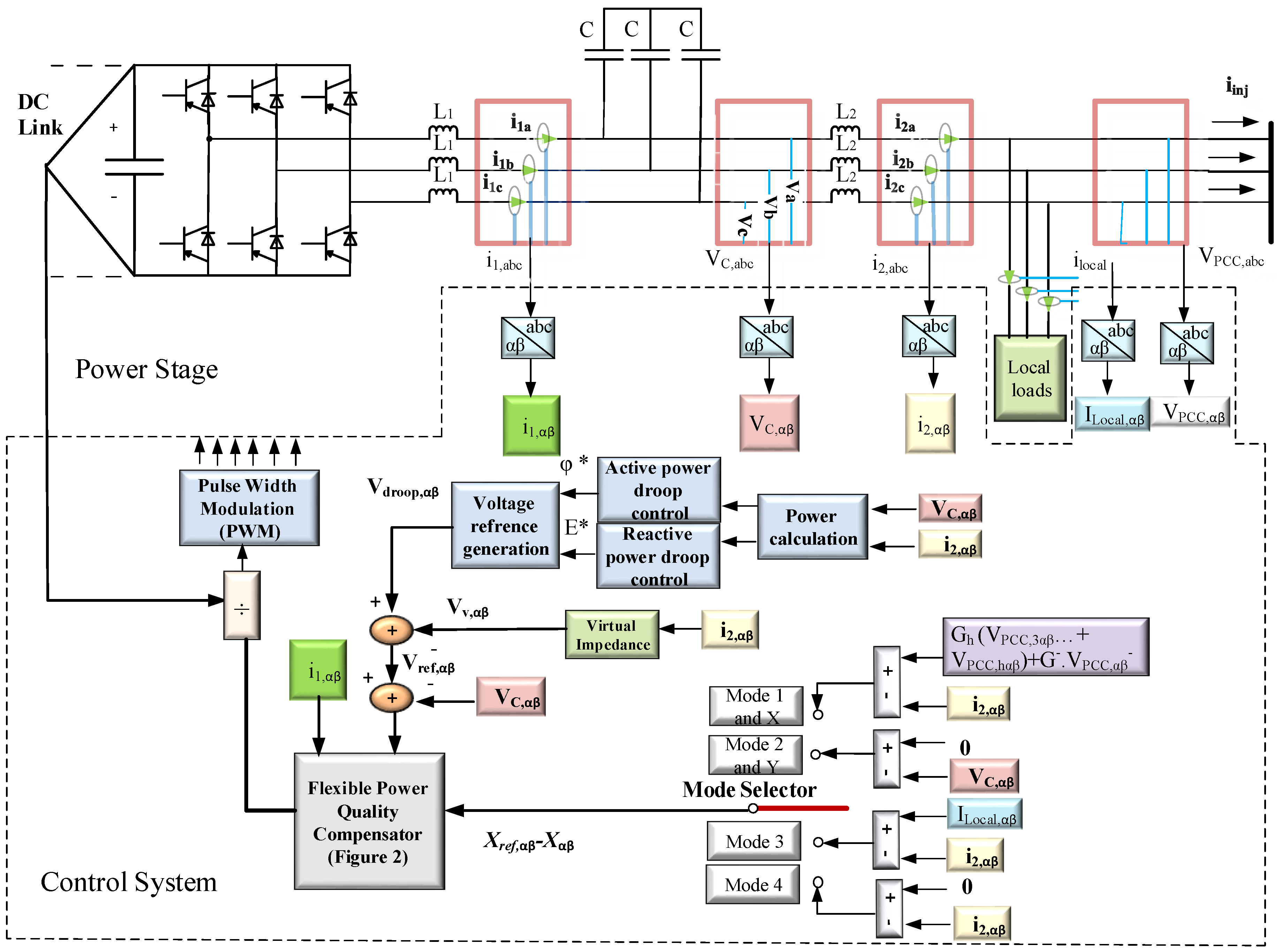
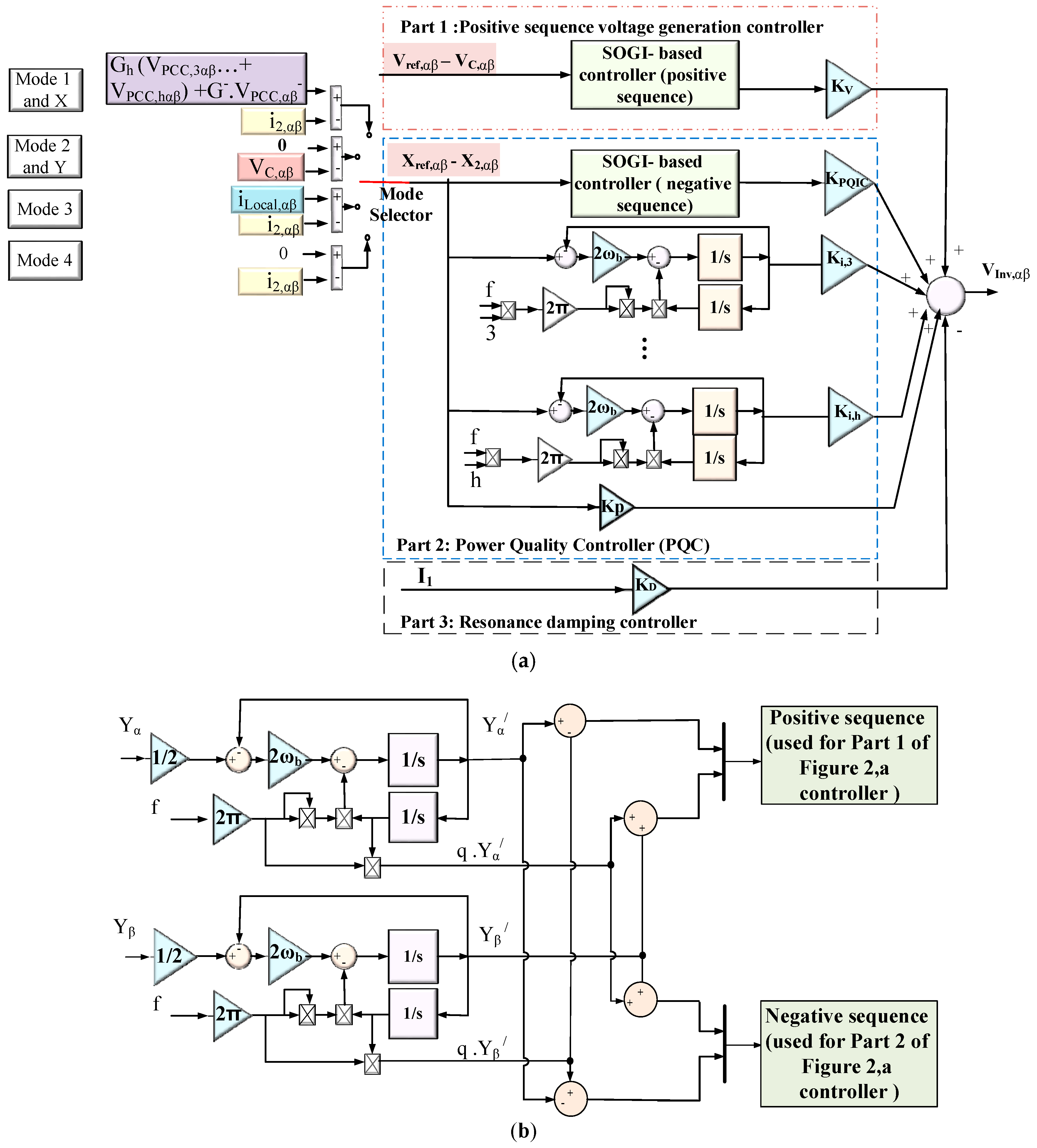


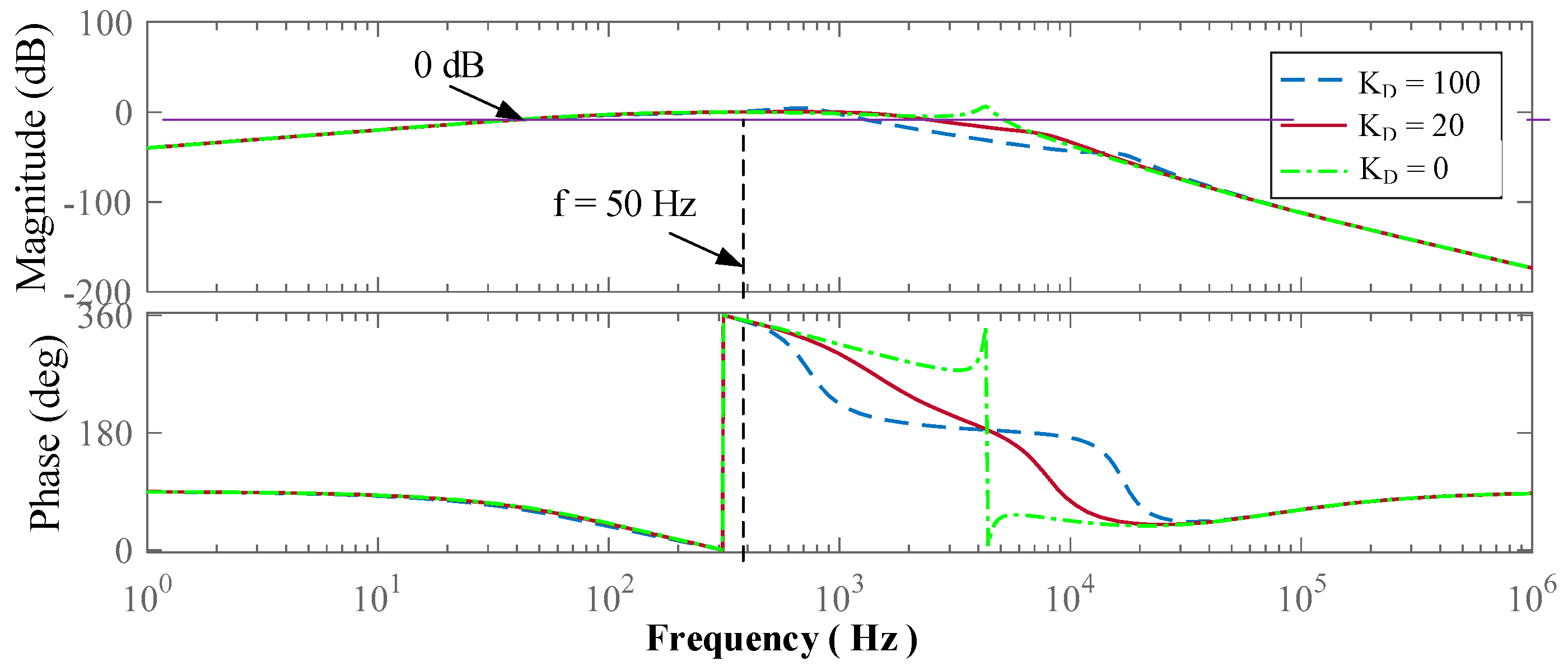
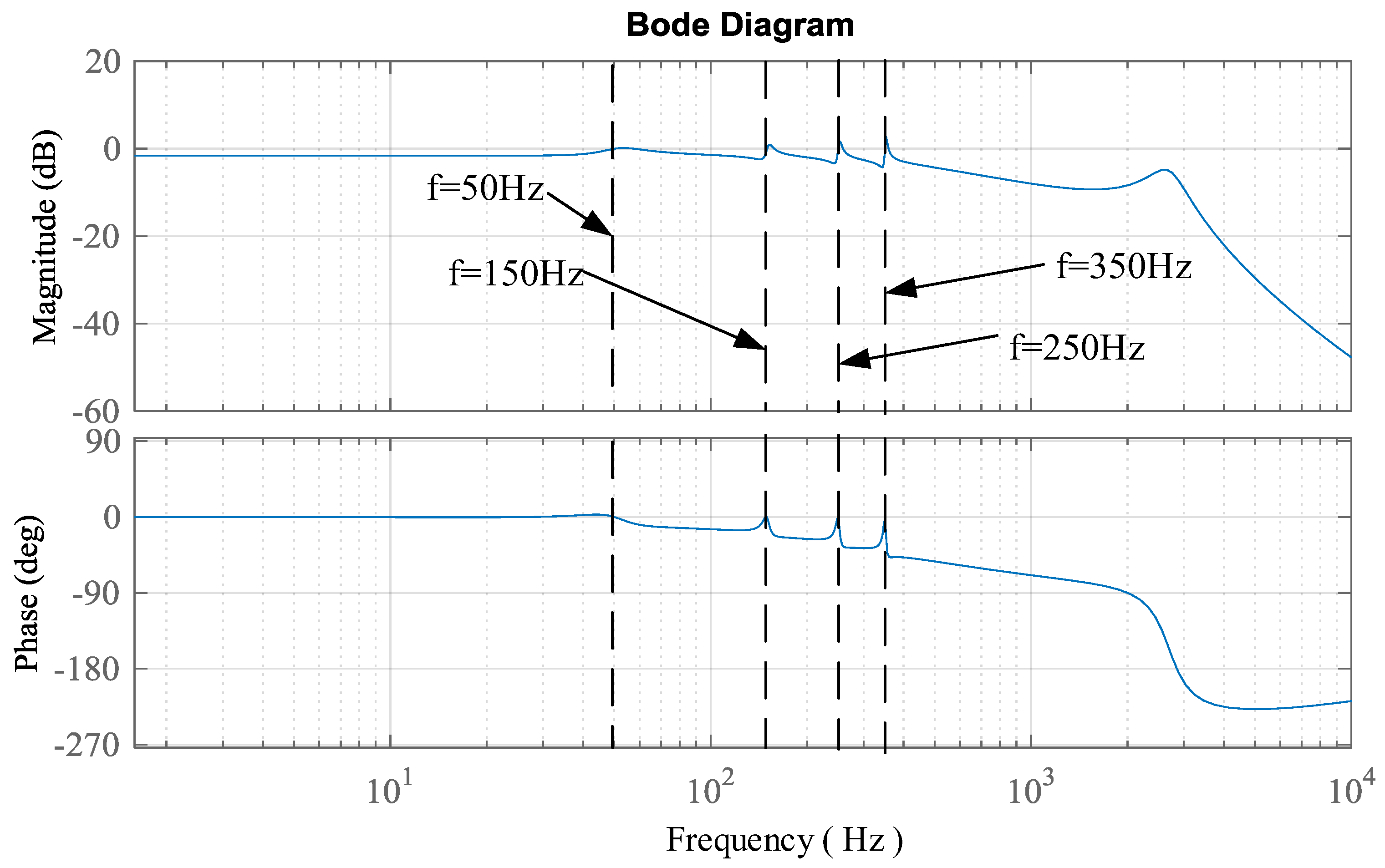
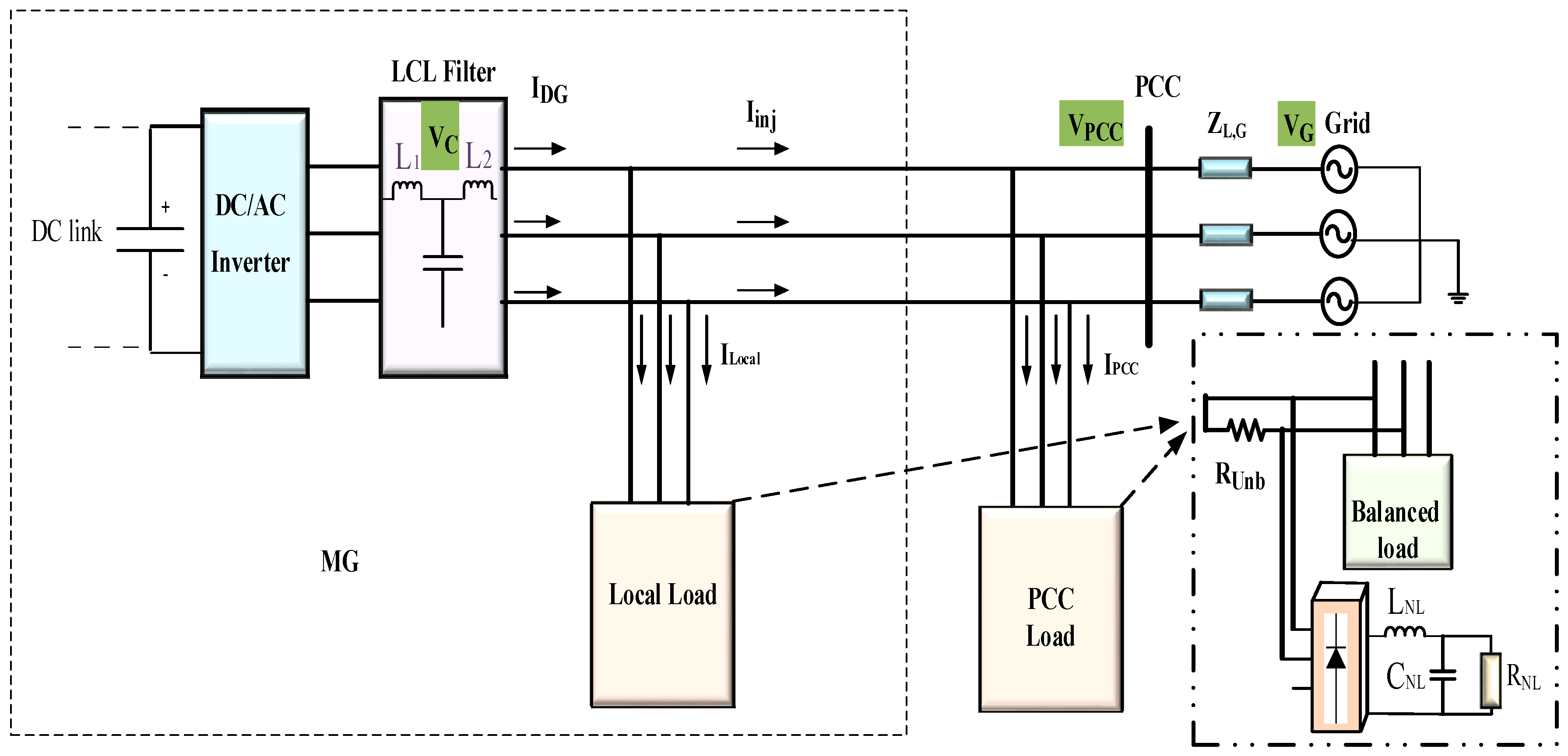
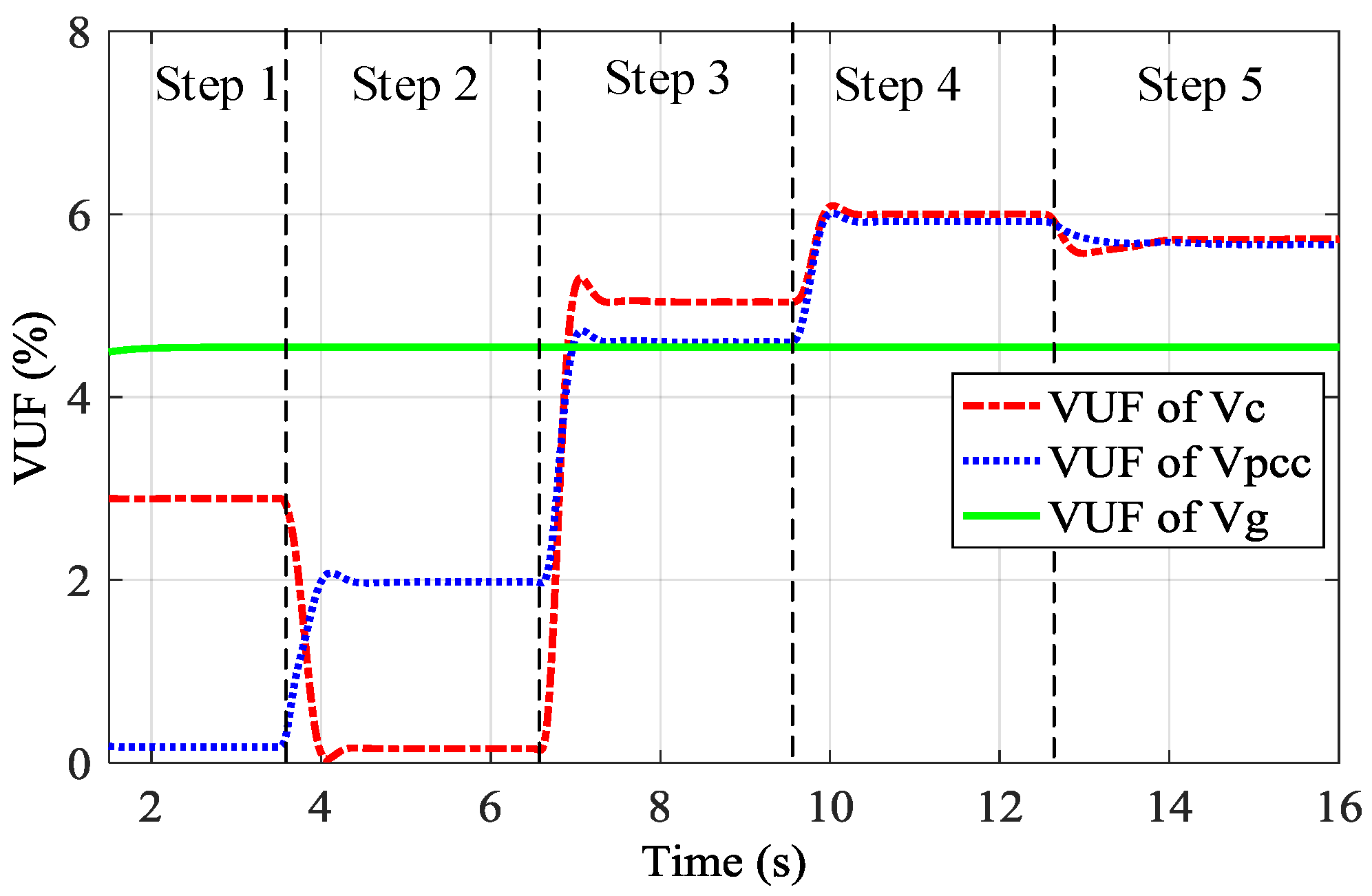
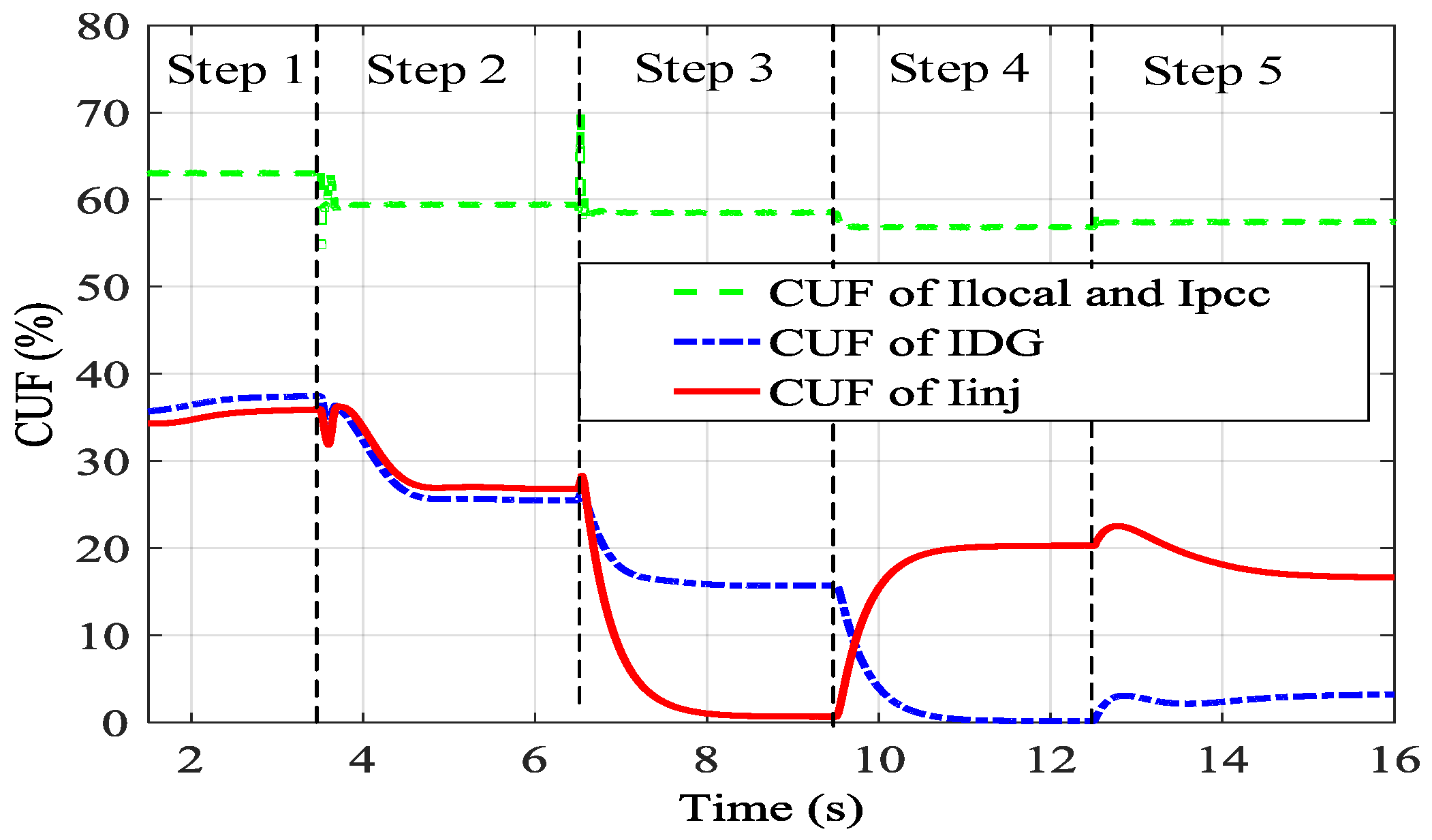
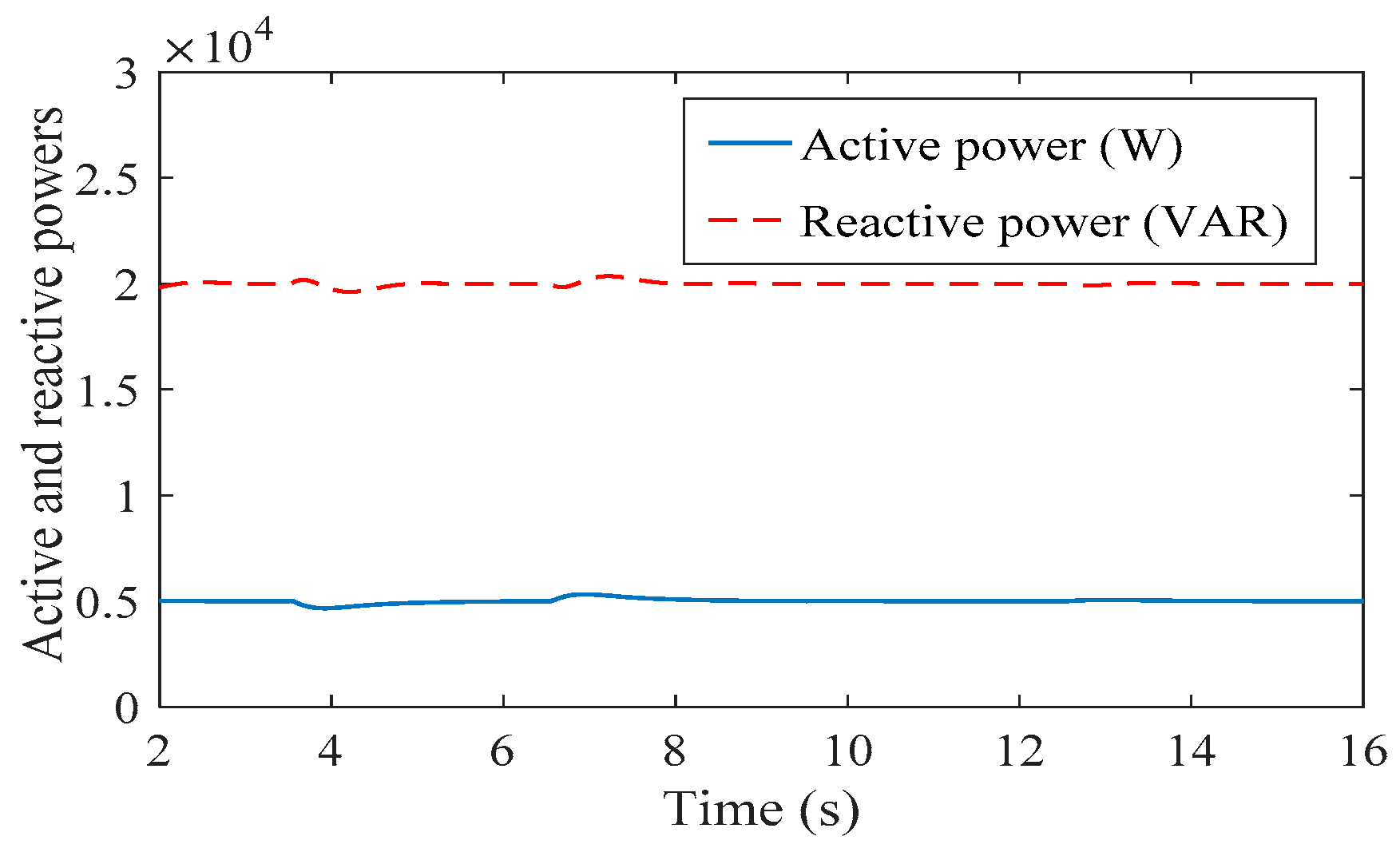
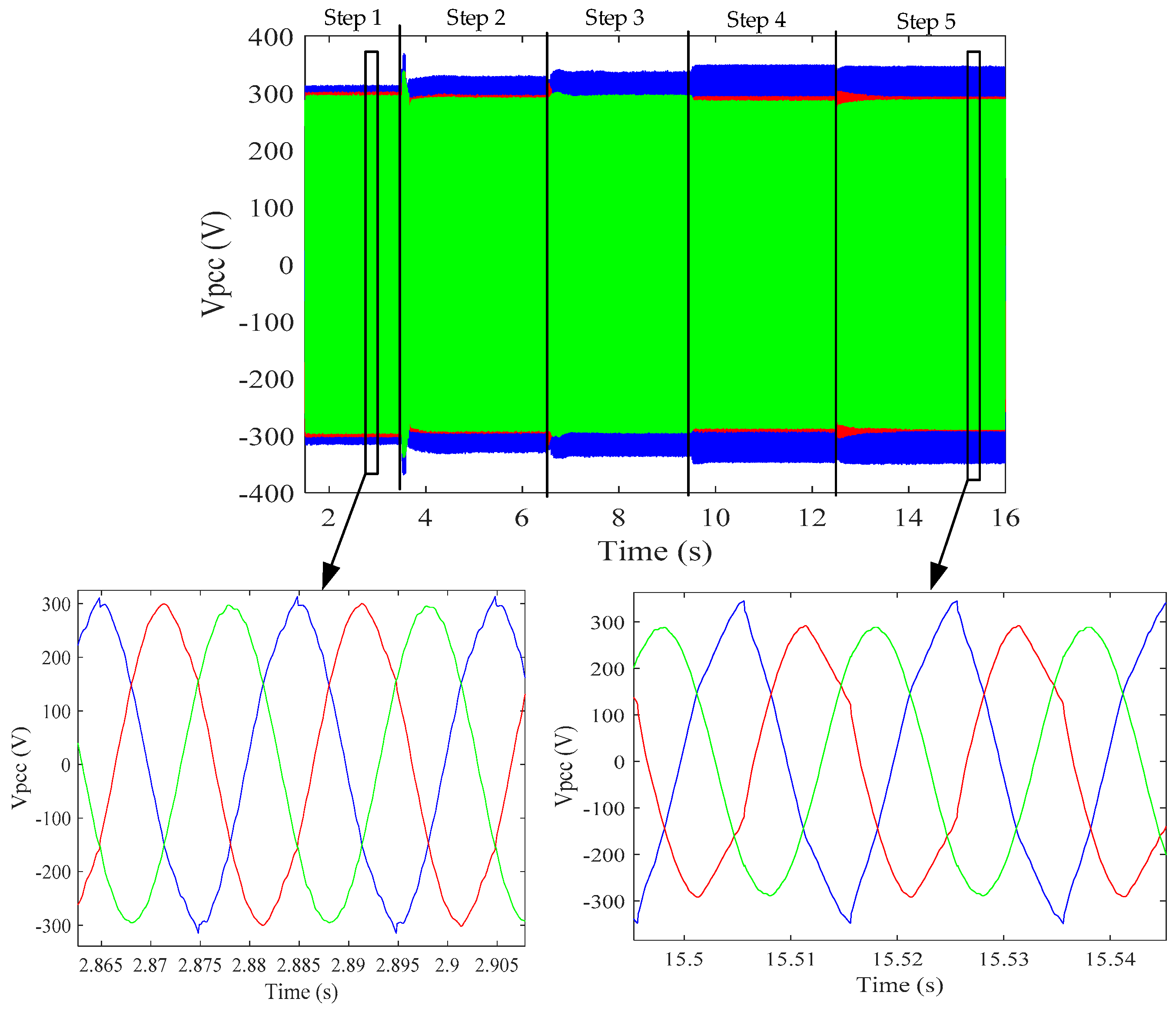
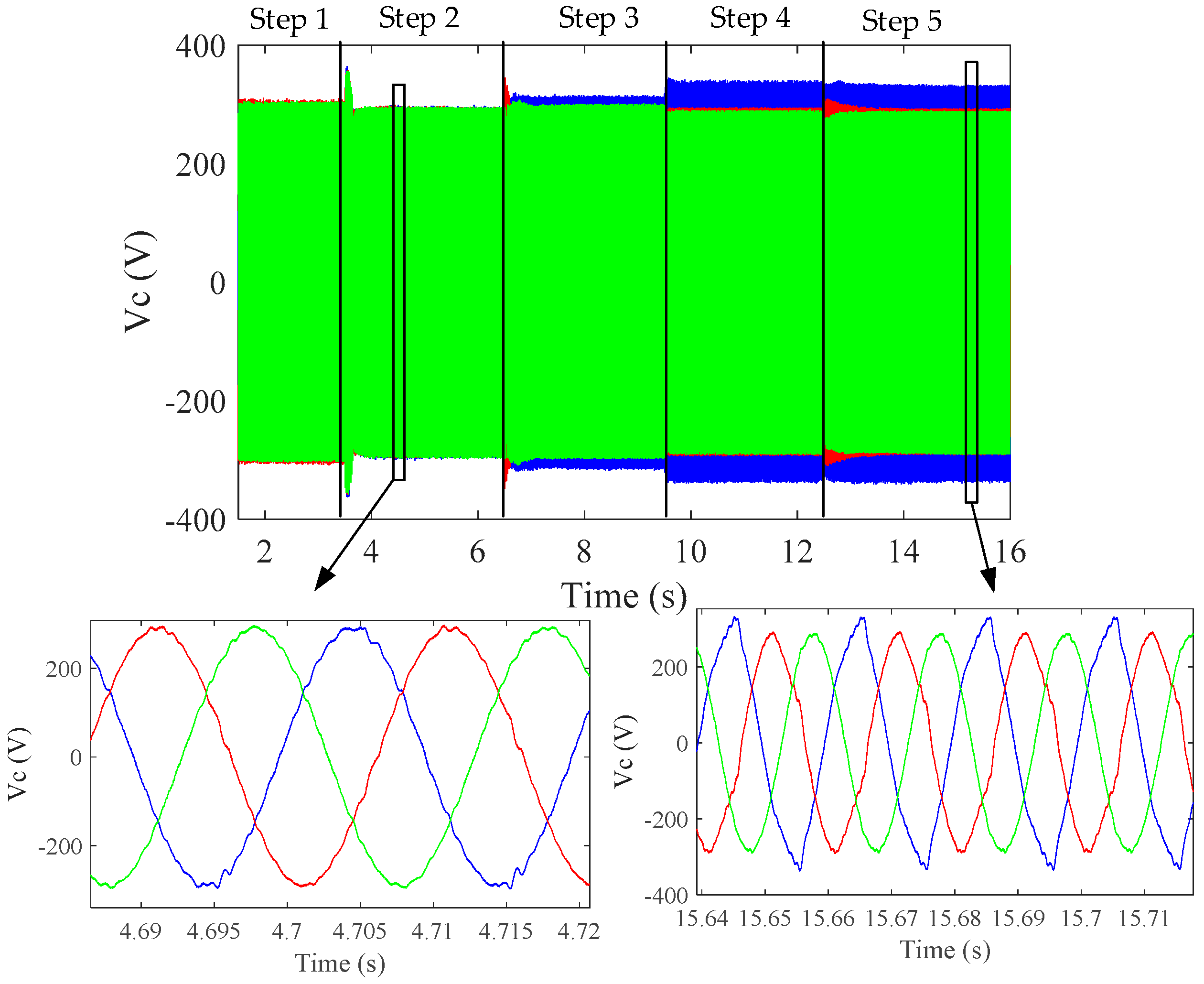
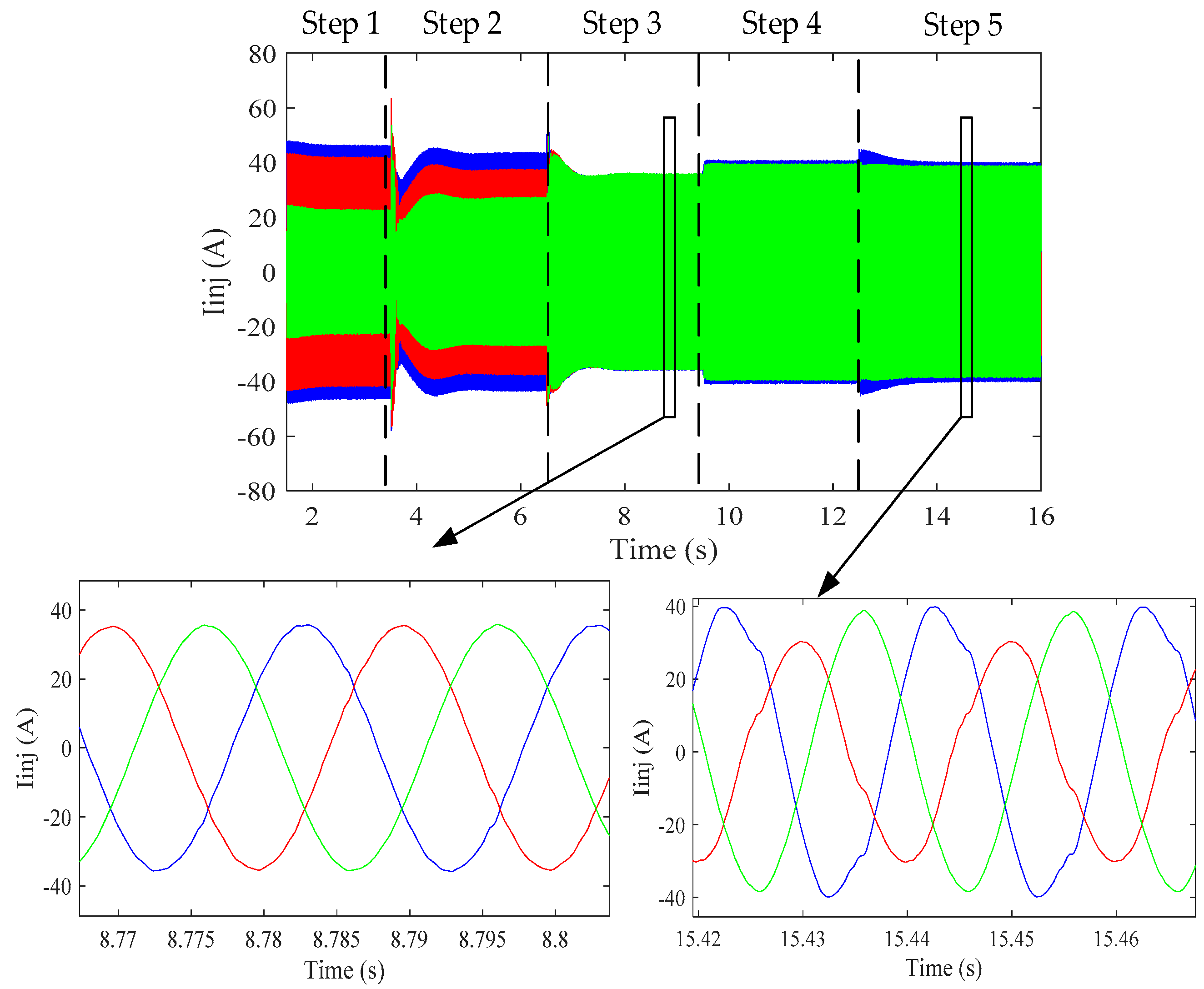

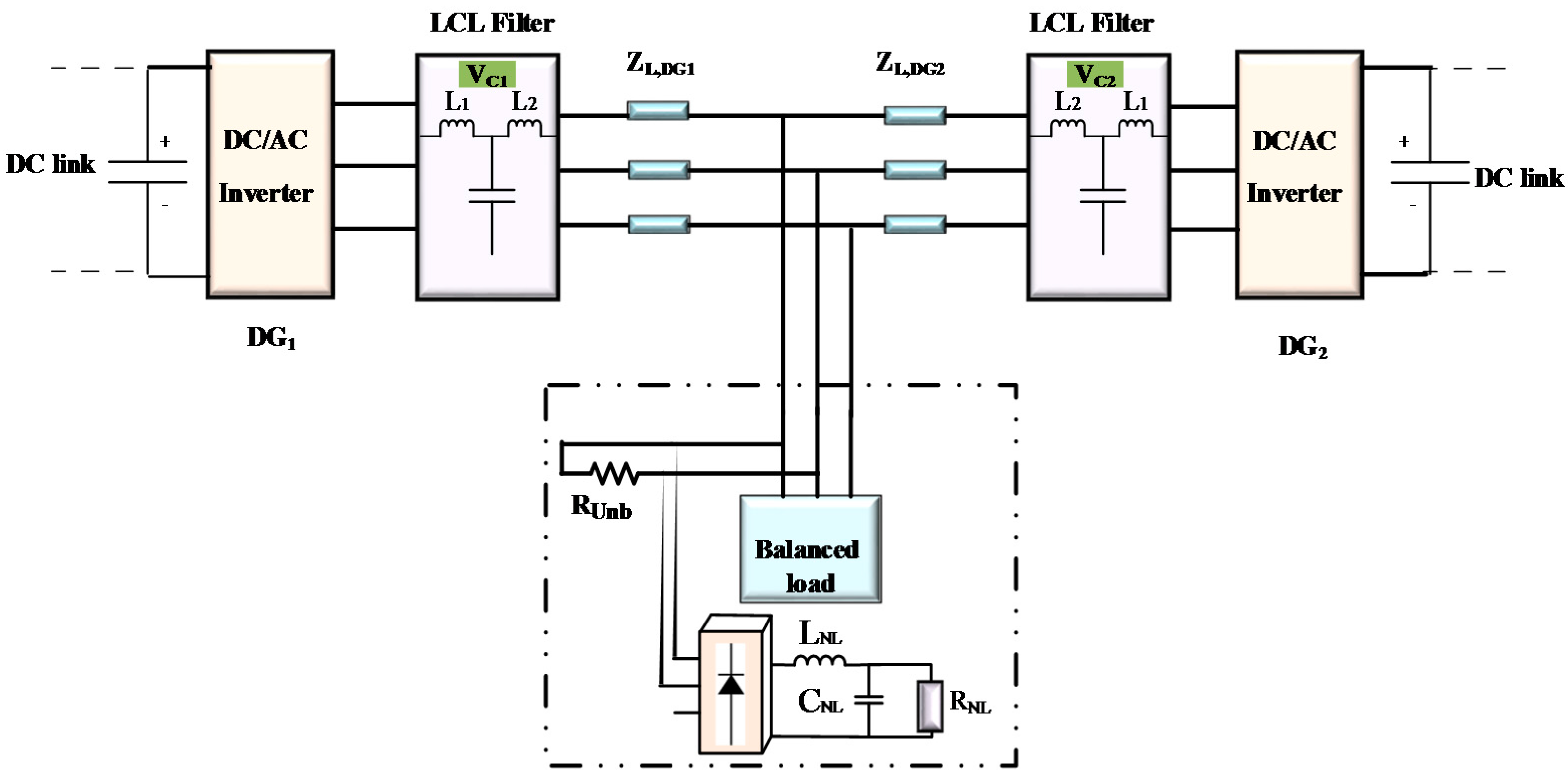
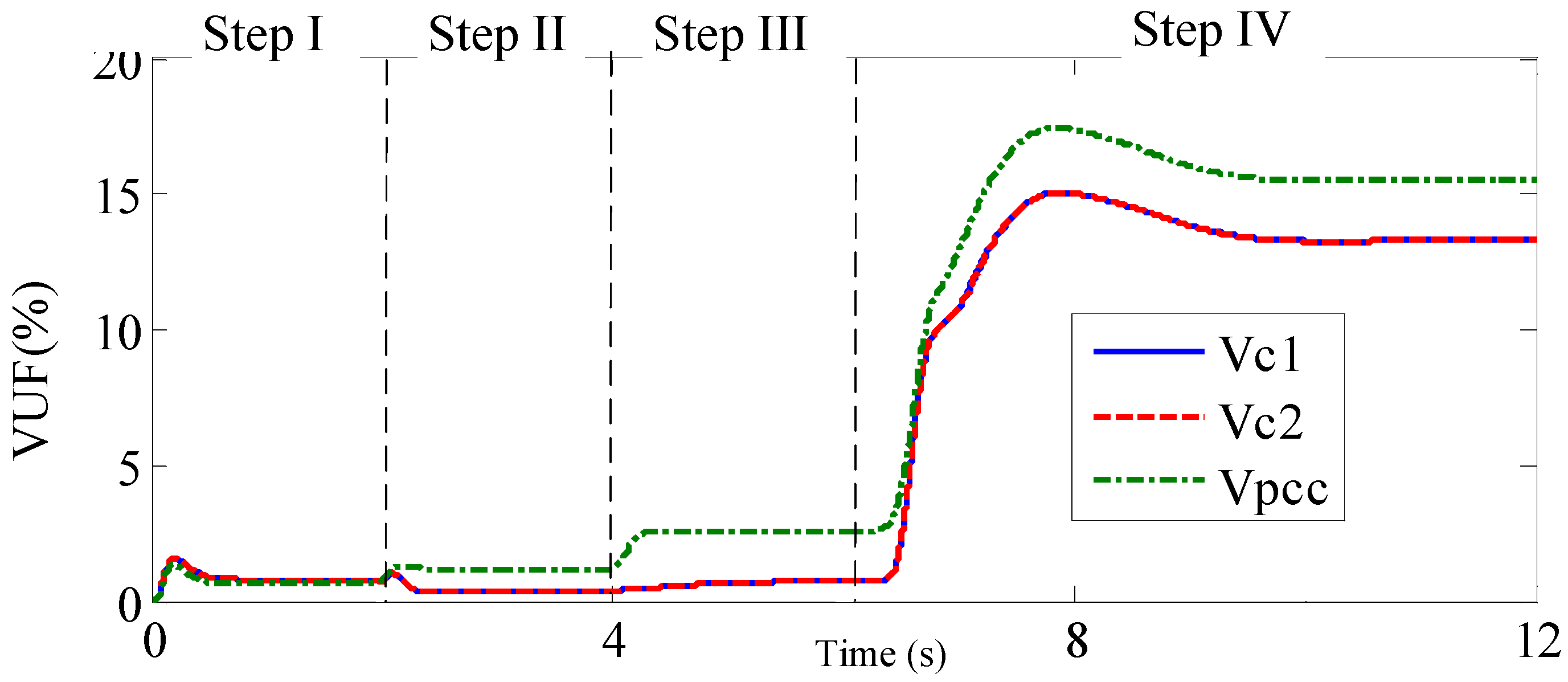
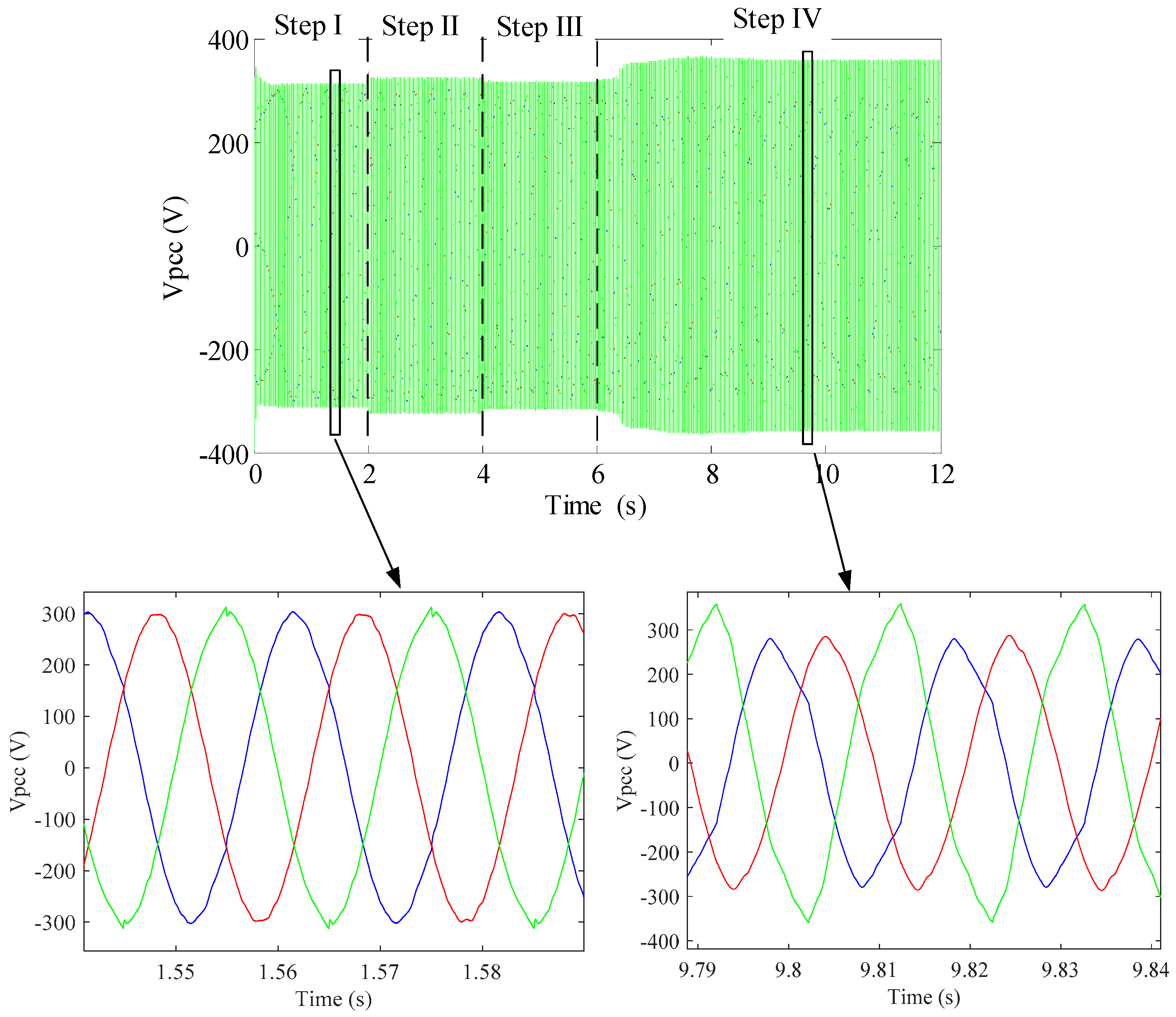
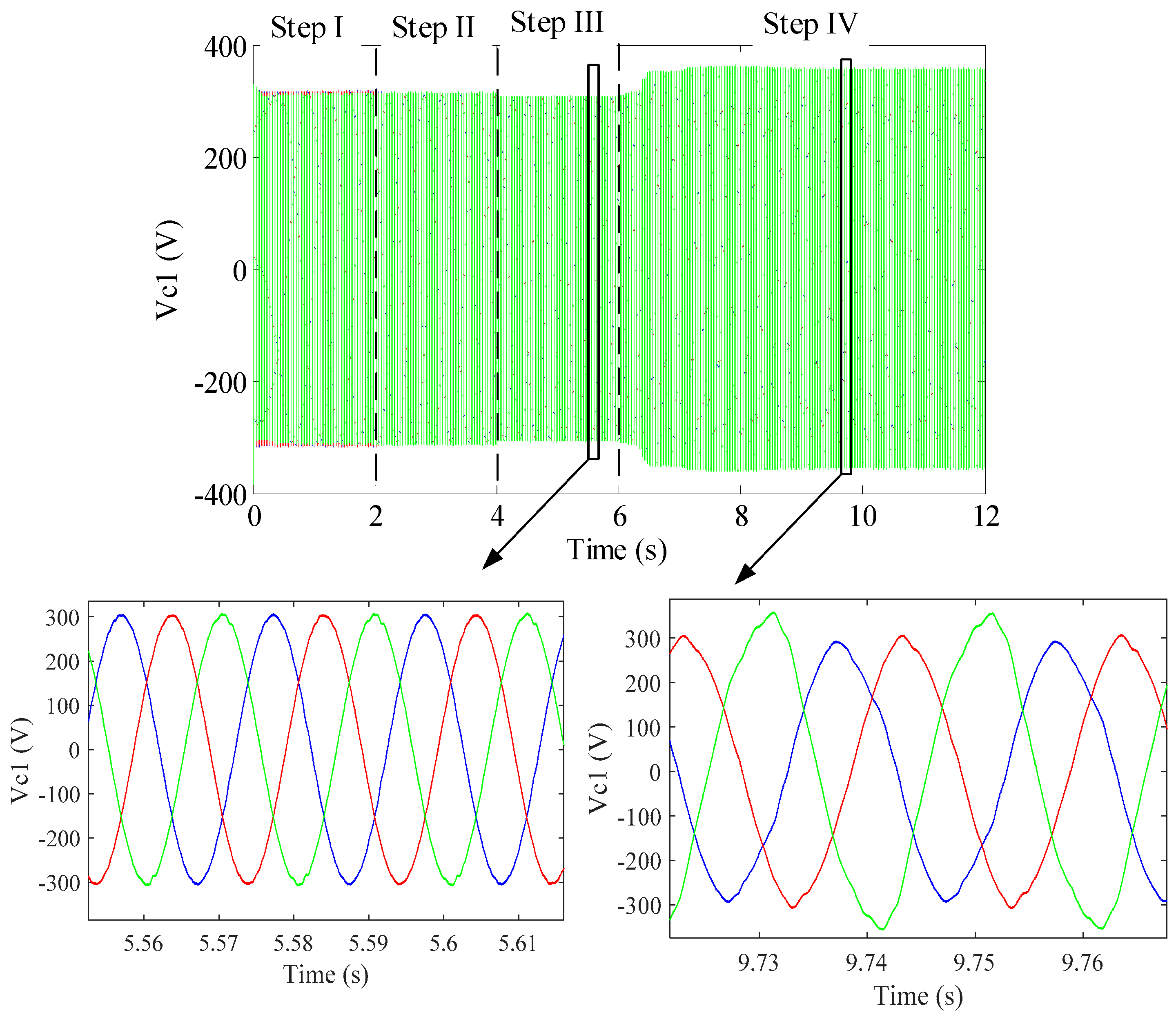
| DC Link Voltage | LCL Filter (L1/C/L2) | Voltage/Frequency | ||||
|---|---|---|---|---|---|---|
| 650 V | 2.5 mH/20 μF/1.5 Mh | 230 V/50 Hz | ||||
| Nonlinear load | Line impedance | Unbalanced linear local and PCC load | ||||
| CNL (μF) | RNL (Ω) | LNL (mH) | ZLG (Ω) | Runb (Ω) | ||
| 235 | 114 | 0.084 | 0.95j + 1 | 20 | ||
| active and reactive power powers refrence power | Switching frequency | Pulse Width modulatin (PWM) delay | ||||
| Active power reference | Reactive power reference | fs | Ts | |||
| 20 kW | 5 kVAR | 10 kHz | 100 μs | |||
| Parameters of controller | ||||||
| Active power droop coefficients | Reactive power droop coefficients | |||||
| mP | mI | nP | nI | |||
| 1 × 10−5 rad·s−1 | 1 × 10−4 ω | 0.05 | 0.1 | |||
| Voltage and current controllers parameters | ||||||
| KV | KUUC | KI,3/KI,5/KI,7 | KP | KD | ||
| 4 | 700 | 500/300/300 | 4 | 20 | ||
| Virtual admittance for harmonic and unbalance compensation | Virtual impedance for fundamental component | |||||
| G− | Gh | Rv | Lv | |||
| 25 Ω−1 | 1 Ω−1 | 0.1 Ω | 2 mH | |||
| Harmonics | VPCC | VC | IDG | Iinj | |||||||||||||
|---|---|---|---|---|---|---|---|---|---|---|---|---|---|---|---|---|---|
| Steps | H3− | H3+ | H5− | H5+ | H3− | H3+ | H5− | H5+ | H3− | H3+ | H5− | H5+ | H3− | H3+ | H5− | H5+ | |
| Step 1 | 1.1 | 1 | 0.8 | 0.8 | 2.1 | 2.1 | 2.2 | 2.15 | 8 | 7.5 | 5.5 | 5.25 | 5 | 4.9 | 3.75 | 3.5 | |
| Step 2 | 1.5 | 1.3 | 1.5 | 1.2 | 0.05 | 0.05 | 0.05 | 0.03 | 6 | 5.5 | 3.85 | 3.25 | 2.2 | 2 | 1.5 | 1 | |
| Step 3 | 2.2 | 1.75 | 2 | 1.55 | 1.5 | 1.05 | 1.15 | 0.9 | 4.2 | 3.8 | 2.3 | 1.9 | 0.3 | 0.2 | 0.2 | 0.2 | |
| Step 4 | 3.75 | 2.8 | 2.8 | 2 | 3.8 | 3 | 2.85 | 2 | 0.15 | 0.08 | 0.1 | 0.1 | 5.3 | 4.15 | 2.5 | 1.75 | |
| Step 5 | 3.3 | 2.6 | 2.5 | 2 | 3.15 | 2.7 | 2.3 | 2 | 1.75 | 1.4 | 1.3 | 1 | 4 | 2.9 | 1.85 | 1.6 | |
| DC Link Voltage | LCL Filter (L1/C/L2) for Both DGs | Voltage/Frequency | |||
|---|---|---|---|---|---|
| 650 V | 2.5 mH/20 μF/1.5 mH | 230 V/50 Hz | |||
| Nonlinear load | Line impedance for both DGs | Unbalanced linear local and PCC load | |||
| CNL (μF) | RNL (Ω) | LNL (mH) | ZLG (Ω) | ZL (Ω) | |
| 235 | 114 | 0.084 | 0.95j + 1 | 40/20 | |
| Parameter of controller | |||||
| Active power droops coefficients | Reactive power droops coefficients | ||||
| mP | mI | nP | nI | ||
| 1 × 10−5 rad·s−1 | 1 × 10−4 | 0.05 | 0 | ||
| Voltage and current controllers parameters | |||||
| KV | KUUC | KI,3/KI,5/KI,7 | KP | KD | |
| 4 | 700 | 500/300/300 | 4 | 20 | |
| Virtual admittance for harmonics and unbalance compensation | Virtual impedance for fundamental component | ||||
| G− | Gh | Rv | Lv | ||
| 1.8 Ω−1 | 0.8 Ω−1 | 0.1 Ω | 2 mH | ||
| Harmonics | VPCC | VC1 | VC2 | ||||||||||
|---|---|---|---|---|---|---|---|---|---|---|---|---|---|
| Steps | H3− | H3+ | H5− | H5+ | H3− | H3+ | H5− | H5+ | H3− | H3+ | H5− | H5+ | |
| Step I | 0.65 | 0.65 | 0.45 | 0.45 | 1.1 | 0.95 | 1.05 | 1.03 | 1 | 0.95 | 1.05 | 1.04 | |
| Step II | 1.05 | 1 | 1 | 0.95 | 0.02 | 0.042 | 0.013 | 0.02 | 0.015 | 0.04 | 0.015 | 0.015 | |
| Step III | 1.1 | 1.05 | 1.05 | 0.9 | 0.025 | 0.05 | 0.018 | 0.03 | 0.02 | 0.05 | 0.02 | 0.025 | |
| Step IV | 4 | 1 | 1.2 | 1.6 | 3.3 | 3 | 0.6 | 1.05 | 3.3 | 3 | 0.6 | 1.5 | |
© 2017 by the authors. Licensee MDPI, Basel, Switzerland. This article is an open access article distributed under the terms and conditions of the Creative Commons Attribution (CC BY) license (http://creativecommons.org/licenses/by/4.0/).
Share and Cite
Mousazadeh Mousavi, S.Y.; Jalilian, A.; Savaghebi, M.; Guerrero, J.M. Flexible Compensation of Voltage and Current Unbalance and Harmonics in Microgrids. Energies 2017, 10, 1568. https://doi.org/10.3390/en10101568
Mousazadeh Mousavi SY, Jalilian A, Savaghebi M, Guerrero JM. Flexible Compensation of Voltage and Current Unbalance and Harmonics in Microgrids. Energies. 2017; 10(10):1568. https://doi.org/10.3390/en10101568
Chicago/Turabian StyleMousazadeh Mousavi, Seyyed Yousef, Alireza Jalilian, Mehdi Savaghebi, and Josep M. Guerrero. 2017. "Flexible Compensation of Voltage and Current Unbalance and Harmonics in Microgrids" Energies 10, no. 10: 1568. https://doi.org/10.3390/en10101568






